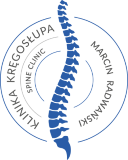PROBLEMS OF THE SPINE
90% of back pain comes from the disc. So if your back hurts, it’s almost certainly a disc problem! Injury to the intervertebral disc (disk) is usually manifested by pain in the spinal muscles at the level of the damaged disc. In addition, when the spinal nerve is compressed by the disc tissue, pain in the leg is most common. In the case of the lumbar section, disc damage is most often diagnosed as “radiculitis”, or lumbago. Pain may occur centrally in the spine, in the transverse line of the spine, it can be unilateral, bilateral or asymmetric (one side hurts more). Very often, damage to the disc in the area of the lumbar or cross causes pain transferred to the buttock, hip or groin.
When the protruding fragment of the disc begins to press on the elements of the nervous system (spinal cord, spinal nerve), neurological symptoms may appear, such as numbness / tingling or a decrease in muscle strength in the limb, e.g. foot drop or inability to climb on the toes. The greater the pressure on the nerve, the pain goes down to the lower parts of the limb. Most of our patients report that ailments appear during prolonged, hunched sitting. The worst for our spine is the hunched position adopted for a long time, e.g. working at the computer, sitting on the couch. Hours spent in this position, lack of preserved lordosis in the lumbar and cervical sections, and the head pushed forward trigger a chain of changes, which in the initial stages occur in the form of tense muscles, pain, stinging or burning, and over time lead to more serious disc damage.
The progression of the disease is usually gradual and not sudden, such as when lifting something from the floor, where the pain appears as a gunshot and immobilizes in a bent position. The process of disc destruction is slow, often lasting for years or even decades. The signals appear recurrently and the development is usually gradual. We usually feel them in the form of a limited range of motion in a certain direction, e.g. limited head turn to the right / left, inability to quickly get up and straighten up after a long sitting in a hunched position. Turning from side to side while lying down can also be painful. Pain may also be felt when sneezing or coughing for problems with the lumbar region.
This problem affects a very large part of society. The interview with the patient shows that pain problems most often appear after prolonged sitting in a hunched position. The lack of proper exercises to compensate for the wrong posture while sitting, the lack of the correct pattern of sitting posture, the lack of the right amount of exercise / sport, time spent in the car, working in front of the computer and evenings spent on the couch lead to degenerative changes in the structures of the spine. These patterns are often used for years. That is why it is so important to introduce correct habits in everyday life, especially when it comes to sitting position.
In response to the above degenerative processes, we recommend a special therapy aimed at reversing and eliminating the resulting changes. The therapy consists of an appropriate procedure on the soft tissues of the spine. The foundation of this therapy are exercises that introduce biomechanical balance.
To quote my mentor – Robin McKenzie, whose method I use as a certified therapist, if every day we spend time brushing our teeth or washing our hands, then why do we forget about our spine, which is supposed to serve us for life?!
”I’d like to see people treating their
own
back pain in the same way they approach
dental care or washing their hands.
It should be just automatic.”
– ROBIN MCKENZIE

